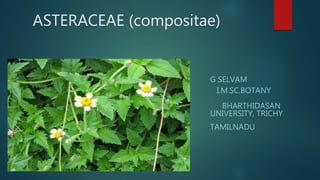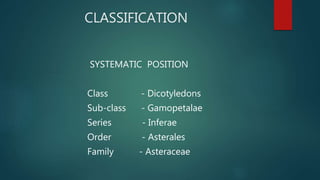Asteraceae
- 1. ASTERACEAE (compositae) G SELVAM I.M.SC.BOTANY BHARTHIDASAN UNIVERSITY, TRICHY TAMILNADU
- 2. CLASSIFICATION SYSTEMATIC POSITION Class - Dicotyledons Sub-class - Gamopetalae Series - Inferae Order - Asterales Family - Asteraceae
- 3. DISTRIBUTION The family Asteraceae includes about 950 genera with probably 20,ooo species. The family comparises about 10% of the total number of flowering plants. In india family is represented by 697 species . They can live in all types of localities such as deserts , arctic regions and aquatic habitats
- 4. Vegetative Characters Habitat : The plants are usually herbaceous annuals or shrubs. The plants contain a milky or watery or resinous sap. Outer surface of these plants is covered with different types of hairs. ROOT : The roots constitute a branched , tap-root system. STEM : The stem is herbaceous or woody and erect. It is tuberous in Helianthus tuberosus and leaf-like in Baccharis.
- 5. LEAVES : The leaves are usually alternate , simple , petiolate and extipulate. In some species leaves are opposite (eg.Helianthus) or whorld (eg.Eupatorium). Sometimes , The leaves may be pinnately or palmately lobed. leaf Surface is covered with hairs. Leaf margin may be entire or Serrate.
- 6. FLORAL CHARACTERS INFLORESCENCE : The inflorescence is a racemose or capitulum. A capitilum consists of disc florets in the centre surrounded by ray florets and an involucre. The florets are arranged in centripetal manner. The extended base of the capitulum is called a receptacle. FLOWER : The flower are bisexual or unisexual or polygamous, rarely neuter. They usually pentamerous , bracteates, sessile and epigynous. There are two types of flowers, namely Disc florets and Ray florets .
- 7. TWO TYPES OF FLOWERS
- 8. TWO TYPES OF FLOWER DISC FLORET RAY FLORET
- 9. DISC FLORET : The disc floret occupy the centre of the capitulum. They are bracteates, sessile , bisexual, regular, actinomorphic and epigynous. CALYX : The calyx is usually represented by a pappus. The pappus is considered to be a reduced and highly modified calyx. In some cases, the calyx is represented by spines
- 10. COROLLA : The corolla is tubular or discoid. It consists of 5 united petals (Gamopetalous). Aestivation is valvate. The corolla tube is swollen near the base of the style. ANDROECIUM : The Antroecium consists of 5 epipetalous stamens. The stamens are alternate to petals. The filaments remain free, but anthers are united into a tube around the style. This is called Syngenesious condition. The anthers are dithecous, introse and dehiscing by longitudinal slits. GYNOECIUM : The gynoecium is bicarpellary and syncarpous. Ovary is inferior and unilocular. There is a single anatropous ovule in the locule on basal placentation. The style is slender and branched. There are two stigmas with various forms.
- 11. FRUIT : The fruit is a cypsela with pappus. SEED : The seed is dicotyledonous and exalbuminous. RAY FLORET : Ray floret occupy the periphery of capitulum. They are bracteates, sessile, irregular, zygomorphic, ligulate and epigynous. CALYX : The calyx is pappus-like or absent.
- 12. COROLLA : The corolla is ligulate (strap-shaped), eg. Bilabiate (the upper lip is 3-lobed and lower lip is 2- lobed. It consists of 5 fused petals (Gamopetalous). Aestivation is valvate. ANDROECIUM : In homogamous heads, the ray flower are bisexual so they have 5 syngenesious stamens.In heterogamous heads, ray florets are usually pistillate or neuter, so stamens are altogether absent.
- 13. GYNOECIUM : Bicarpellary, syncarpous, inferior ovary with a single locule as in disc florets ovule is one and placentation is basal. Style is bilobed and stigma is variable. FRUIT : Cypsela SEED: Dicotyledonous and exalbuminous.
- 14. COMMON PLANTS Helianthus annuus(Suryakanthi) Eclipta prostrata(karisilanganni) Tridax procumbens(Vettukkaaya-thalai)
- 15. Tagetes erecta(sevvannthi) Calendula officinalis(Thulukka Saamanthi)
- 17. CLASSIFICATION SYSTEMATIC POSITION CLASS - Dicotyledone Sub-class - Gamopetalae Series - Inferae Order - Asterales Family - Asteraceae Genus - Tridax Species - procumbens
- 18. Tridax procumbens HABITAT : Tropical and sub-tropical regions, perennial herb. STEM : Cylindrical, branched, erect. LEAF : Simple, ovate, serrate margin, Reticulate ,opposite decussate , Aromatic. INFLORESCENCE : Head or capitulum
- 19. RAY FLORET : Bracteate, zycomorphic, sessial,unisexual, Peripharal. Calyx : pappus like structure. COROLLA : 3 or 4 valvate Aestivation Gamopetalous, Androecium and Gynoecium absent.
- 20. DISC FLORET : Bracteate, Actinomorphic, bisexual , Inferior ovary. CALYX : pappus like structure. COROLLA : 5 Gamopetalous valvate Aestivation. ANDROECIUM : Syngenesious stamens. GYNOECIUM : Bicarpellary , syncarpous, unilocular, basal Placentation, style, slender and branchd, inferior ovary. FRUIT : Cypsela
- 22. ECONOMIC IMPORTANCE 1.OIL : Many plants gives oil seeds to extract oils. The oil is used for cooking, burning, soap- making, varnish preparations and as lubricant. Examples – Helianthus annuus (Suryakanthi) – Seed Carthamus tinctorius (Sendurakam) – Flower Guizotia abyssinica (Payellu) – Seed 2.DYES : Some plants yield dyes for colouring different materials. Flower heads of Carthamus tinctorius gives a red dye called safflower. Flower heads of Tagetes erecta (Tulukka-samandi) gives a yellow-dye for colouring cotten
- 23. 3.FOOD : Leaves of Cichorium intybus (kasini keerai) are used in salads. Root powder of those plants is a substitute for coffee or often mixed with coffee. Leaves Lactuca sativa (Lattuce keerai) is used in salads. 4.MEDICINES : Whole plant extract of Artemisia absinthium (machipattri) is given for fever and inflammation of liver. Artemisia vulgaris (makkippu) is used for round worms, fever, asthma and nervous disorders.
- 24. 5.ORNAMENTAL PLANTS : Tagetes erecta(sevvanthi) Helianthus annuus(Suryakanthi)
- 25. Calendula officinalis(Thulukka saamanthi) Parthenium hysterophorus(mookuthi poo)

























